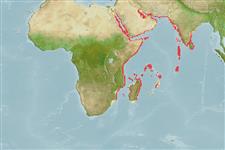Hexacorallia |
Scleractinia |
Acroporidae
Environment: milieu / climate zone / depth range / distribution range
Ecology
Reef-associated; depth range 5 - 25 m (Ref. 98471). Tropical; 30°N - 28°S, 32°E - 83°E (Ref. 846)
Indo-West Pacific.
Length at first maturity / Size / Weight / Age
Maturity: Lm ? range ? - ? cm
Sheltered reef slopes (Ref. 846) and lagoons (Ref. 86439). In khor channels characterized by a fast current flow where it is attached to rocks in isolated clumps (Ref. 102838).
Life cycle and mating behavior
Maturity | Reproduction | Spawning | Eggs | Fecundity | Larvae
Hermaphroditic (Ref. 113708). Mature gametes are shed into the coelenteron and spawned through the mouth. Life cycle: The zygote develops into a planktonic planula larva. Metamorphosis begins with early morphogenesis of tentacles, septa and pharynx before larval settlement on the aboral end (Ref. 833).
Wallace, C.C. 1999 Staghorn corals of the world. A revision of the genus Acropora (Scleractinia; Astrocoeniina; Acroporidae) worldwide, with emphasis on morphology, phylogeny and biogeography. CSIRO Publishing. 421 p. (Ref. 86439)
IUCN Red List Status
(Ref. 130435: Version 2025-1)
CITES status (Ref. 108899)
Not Evaluated
Threat to humans
Human uses
| FishSource |
Tools
More information
Trophic EcologyFood items (preys)
Diet composition
Food consumption
Predators
Population dynamicsGrowth
Max. ages / sizes
Length-weight rel.
Length-length rel.
Length-frequencies
Mass conversion
Abundance
Life cycleReproductionMaturityFecunditySpawningEggsEgg developmentLarvae PhysiologyOxygen consumption
Human RelatedStamps, coins, misc.
Internet sources
Estimates based on models
Preferred temperature
(Ref.
115969): 25.1 - 29.1, mean 27.5 (based on 871 cells).
Price category
Unknown.
